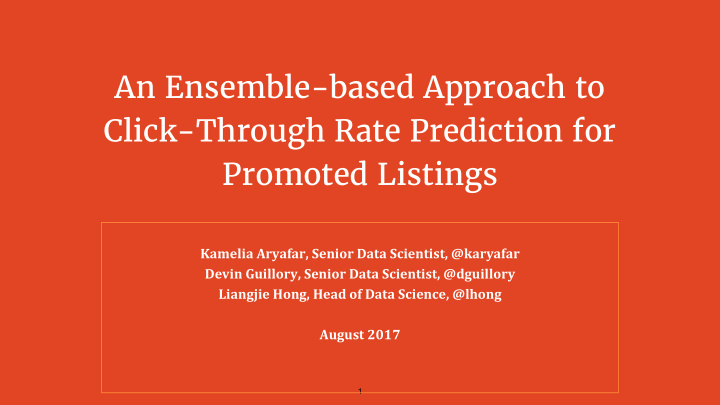



An Ensemble-based Approach to Click-Through Rate Prediction for Promoted Listings Kamelia Aryafar, Senior Data Scientist, @karyafar Devin Guillory, Senior Data Scientist, @dguillory Liangjie Hong, Head of Data Science, @lhong August 2017 1
Takeaways • Etsy’s Promoted Listings Product • System Architecture and Pipeline • Effective Prediction Algorithms and Modeling Techniques • Discuss Correlations between offline experiments and online performance
Promoted Listings Background
Etsy: Background Etsy is a global marketplace where users buy and sell unique goods: handmade or vintage items, and craft supplies. Currently Etsy has > 45M items from 2M sellers and 30M active buyers
Promoted Listings: Background
Promoted Listings: How it works • Sellers specify overall Promoted Listings budget (optional max bid per listing) • Sellers cannot choose which queries they want to bid on. • CPC is determined by a generalized second price auction. 1 •
Promoted Listings: Second Price Auction Bridal Earrings Vintage, Wedding Earr.. Sellers pay minimum bid required to Bid = 0.25 CTR = 0.158 keep their position Score = 0.0395 CPC = 0.13 Initial Stud Earrings A-Z, Personalized.. Bid = 0.95 CTR = 0.0202 Score = 0.01919 CPC = 0.94 Pava Crystal Ball Stud Earrings - Cryst.. Bid = 0.70 CTR = 0.0271 Score = 0.01897 CPC = 0.62 Vintage 18k Yellow Gold South Sea Pe. Bid = 0.45 CTR = 0.0313 Score = 0.0168 CPC = 0.41
CTR Prediction Overview
Promoted Listings: System Overview
Data Collection
CTR Prediction: Data Collection • Training Data: 30 Days Promoted Listings Data • Balanced Sampling • Evaluation Data: Previous Day Promoted Listings Data
Model Training
CTR Prediction: Modeling • P(Y|X)= p(click | ad i ) ~ Logistic Regression • Single Box training via Vowpal Wabbit • FTRL-Proximal Algorithm to learn weights http://hunch.net/~vw/ H. Brendan McMahan, Gary Holt, D. Sculley, Michael Young, Dietmar Ebner, Julian Grady, Lan Nie, Todd Phillips, Eugene Davydov, Daniel Golovin, Sharat Chikkerur, Dan Liu, Martin Wattenberg, Arnar Mar Hrafnkelsson, Tom Boulos, and Jeremy Kubica. 2013. Ad Click Prediction: A View from the Trenches.
Inference
CTR Prediction: Inference
CTR Prediction: Scaling • Calibrate predictions due to Balanced Sampling • Fit predictions to previous day’s distribution
Evaluation
CTR Prediction: Offline Performance • Models trained over days [t-32, t-2], • Model Evaluated over t-1 • Key Metrics: - Area Under Curve (AUC) - Log Loss - Normalized Log Loss
Online Performance • Tracking offline metrics established AUC as target metric • Single digit improvements in AUC -> Single Digit improvement in CTR
Ensemble-Based Model
Featurization • Historical Features - based on promoted listing search logs that record how users interact with each listing • Content-Based Features - extracted from information presented in each listing’s page
Featurization: Historical Features • Per Listing Historical Features: - Types : (Impressions, Clicks, Cart Adds) - Transformations: • Log-Scaling : • Beta Distribution Smoothing :
Featurization: Contextual Features • Per Listing Contextual Features: - Listing Id, Shop Id, Categorical Id - Text Features (Title, Tags, Description) - Price, Currency Code - Image Features (ResNet 101 embedding)
Models & Performance
Data Exploration Initial Insights ● Historical Features - performed highest for frequently occurring listings ● Contextual Features - performed highest for rarely presented listing ● What’s the best way to leverage this information to create an effective model?
Proposed Ensemble Model Data splitting (Warm and Cold) ● Split training data into two cohorts > N and < N impressions, (N=30) ● Train separate models on each warm and cold cohort ● Ensemble models (Stacking) together in order to get best possible predictions
Primary Models Instance Switch Historical Model Historical Features >N Contextual Contextual Features Model
Primary Models ● Warm/Historical Model ○ Trained on high-frequency data ○ Uses Historical Features - Smoothed CTR ● Cold/Contextual Model ○ Trained on low-frequency data ○ Uses Contextual Features (Title, Tags, Images, Ids, Price)
Ensemble Layer IC Instance Historical Historical Features Model Ensemble Model Contextual Contextual Features Model IC = Floor(Log(Impression Count))
Results
Questions
Learned Attentions
Recommend
More recommend